Bianchi Sprint Force eTap AXS review
A well-balanced bike that rewards a hard effort but can also handle long distances
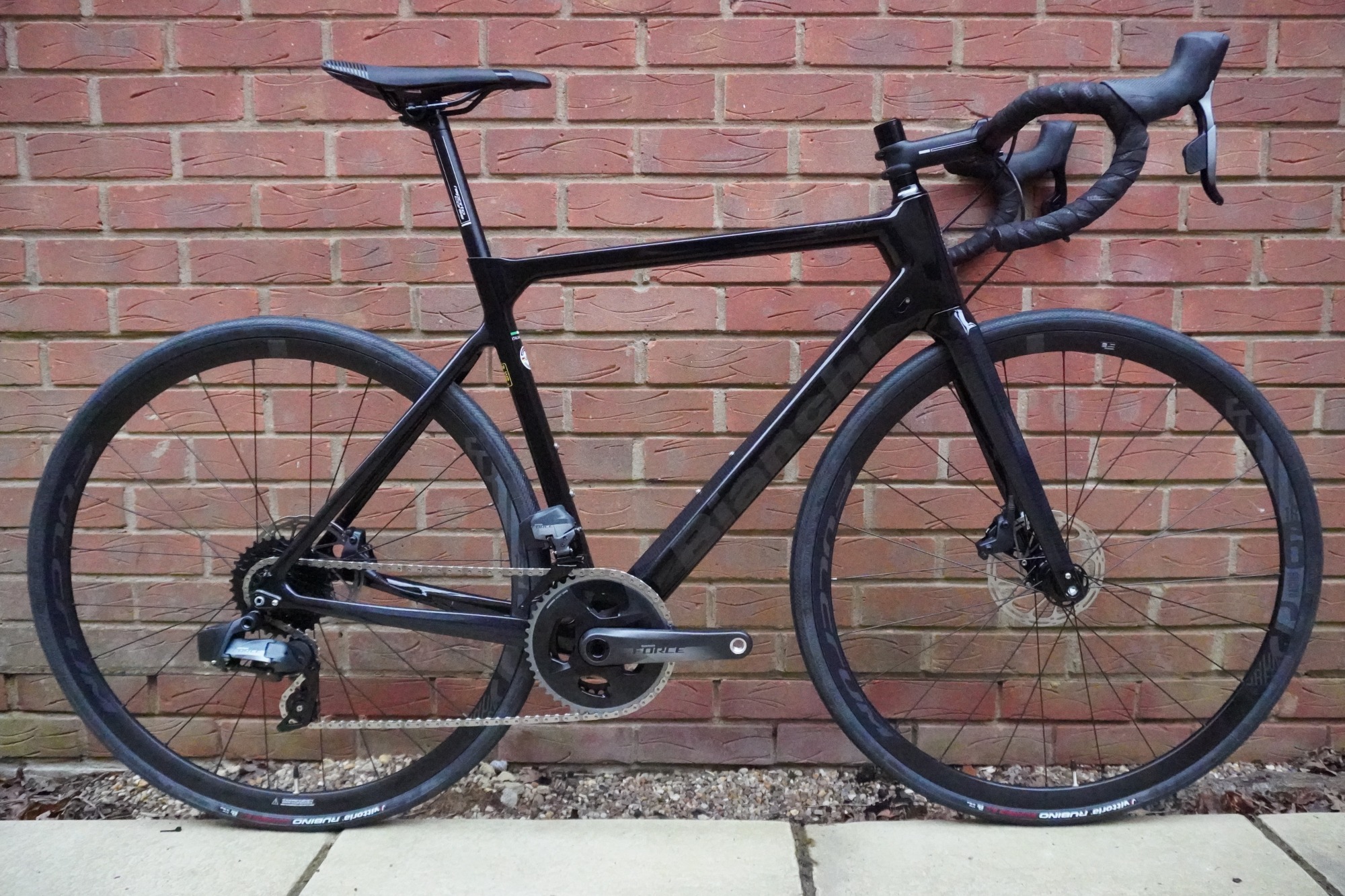
The Bianchi Sprint is a great bike with good handling and a responsiveness that is ripe for racing. It’s also quite comfortable, so longer sportives and Gran Fondos would certainly be on the cards. In eschewing highly integrated and proprietary finishing kit, finding your perfect fit on the Sprint is a much easier and less costly affair than on other more uncompromisingly aero-optimised bikes However, the spec doesn’t quite match the price. There’s a number of bikes around this price point with carbon finishing kit and wheels rather than alloy, with the result that the Sprint isn’t the best choice for maximising the spec sheet
-
+
Accurate handling
-
+
Great power transfer
-
+
Comfortable on long rides
-
+
Refreshingly adjustable cockpit
-
+
Large tyre clearance
-
-
High price for the spec
-
-
Relatively heavy
You can trust Cycling Weekly.

The Bianchi Sprint is designed as an allrounder performance bike, a jack-of-all-trades that you can take to the weekday crit or a weekend road race – and yet will also be comfortable enough to ride on a long sportive or Gran Fondo.
In Bianchi’s range, the Sprint sits below the climbing optimised Specialissima and the World Tour proven Oltre. So, it’s pretty much on the same level as the more aerodynamically focused Aria.
Construction
Frame
Here we have a full carbon construction, with subtle nods towards aerodynamics in the boxy tube shapes – so it should age much more gracefully than some other more highly optimised aero designs, which quickly begin to look quite dated as research progresses and best practice evolves.
The disc brake version takes flat mount brake calipers and has hub spacing of 12x100mm / 12x142mm, which are the standards most manufacturers seem to have settled on (for now at least…).
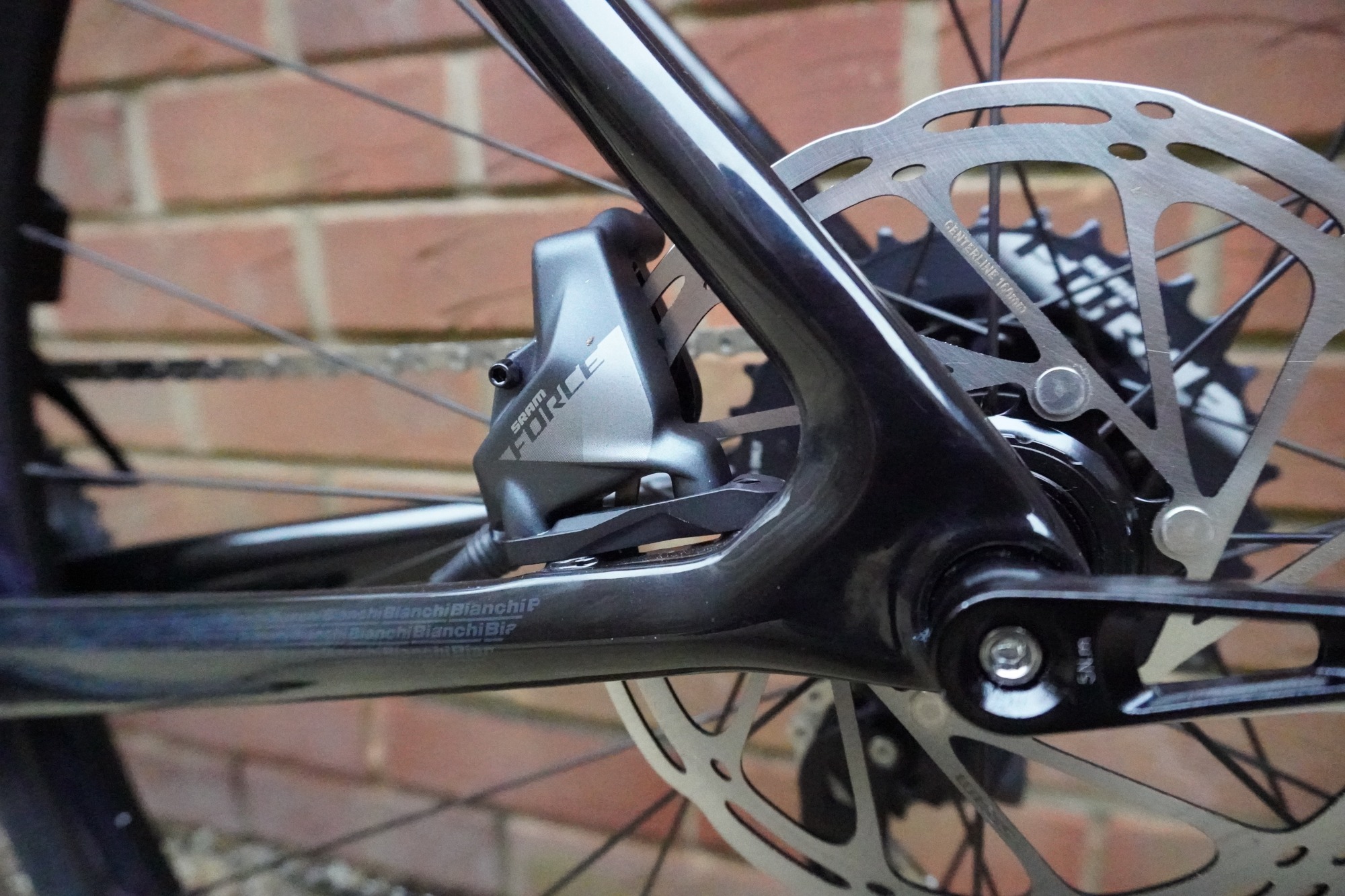
The bottom bracket is a press fit, which on a carbon bike I would say is fair enough. Threads can’t be cut directly into carbon, so to get a BSA bottom bracket on a carbon bike, a threaded metal sleeve has to be pressed into the frame. Although it would save home mechanics having to buy some new tools, it’s easier to see why a bike designer would opt to just forgo the sleeve and simply have the bearings pressed into the frame.
On well made bikes with tight tolerances, the issues of creaking that press fit bottom brackets were initially plagued with are greatly mitigated. No unwanted sounds reared their heads as I rode the Sprint through the second half of the winter and into spring.
There are no mudguard mounts – cunningly hidden or otherwise. But whilst we do see some race bikes that have them, such as those from Ribble, their absence isn’t really a loss for a bike such as this.
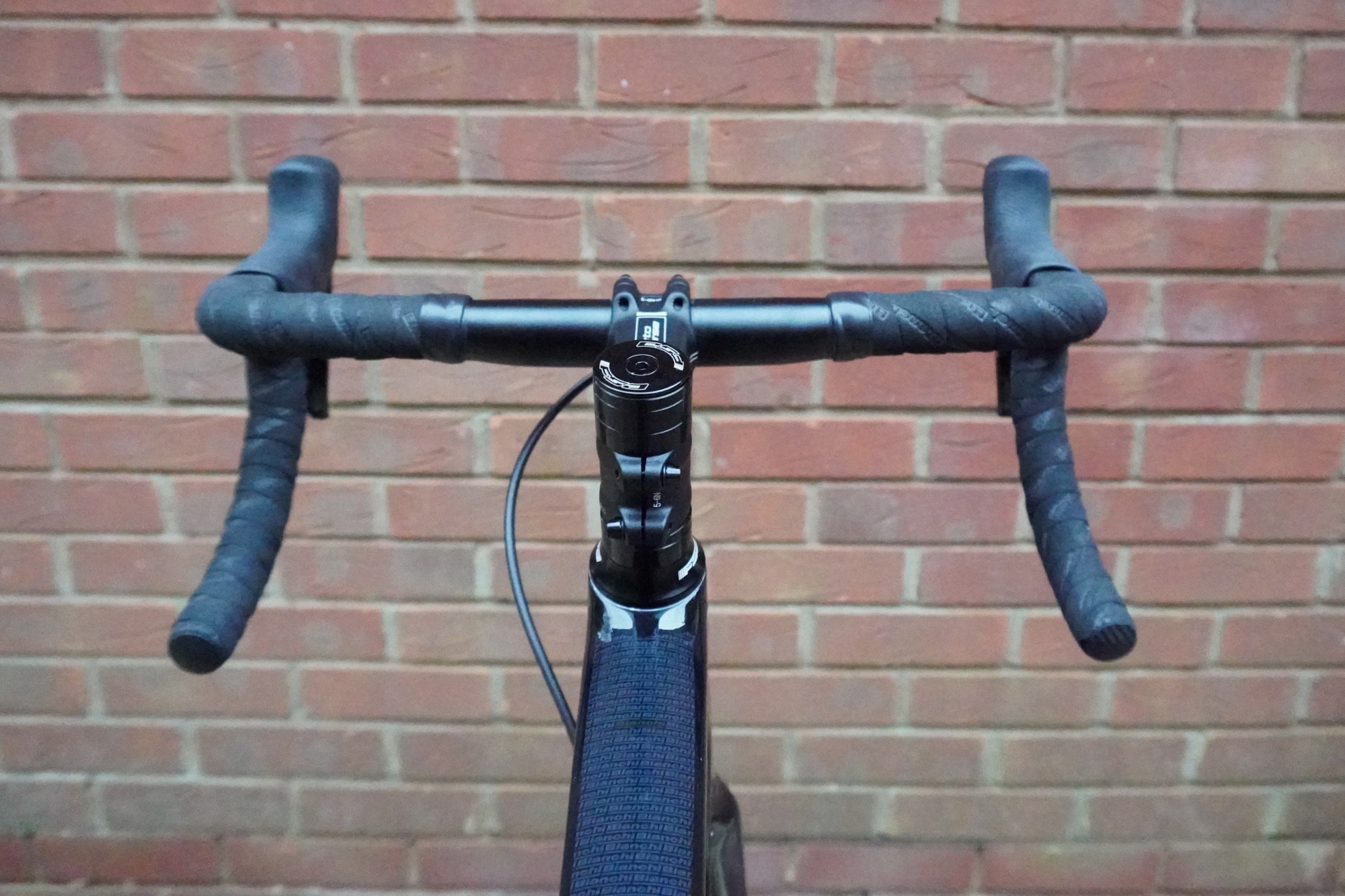
In a size 55, the stack and reach are 545mm and 388mm, respectively. These are pretty typical numbers; you do get some bikes that are a little more extreme – such as the aero focused Aria – but most people will have no problem assuming an aggressive position on Sprint with the right size frame.
The head angle and chainstay length for this size are 73° and 413mm, which is a recipe for a pretty snappily handling bike. What’s good to see is that the chainstays go down to 410mm in the smaller sizes and up to 415mm in the larger ones.
Particularly with carbon bikes where it costs a lot to make different models, many other brands choose to keep the exact same rear end between all the sizes – to the determinant of the handling in the smallest and largest.
Finishing kit
The Sprint’s finishing kit can be viewed in two ways. On the one hand, it’s great to see a 27.2mm seat post and a standard stem/handlebar set up with spacers that can easily be reshuffled.
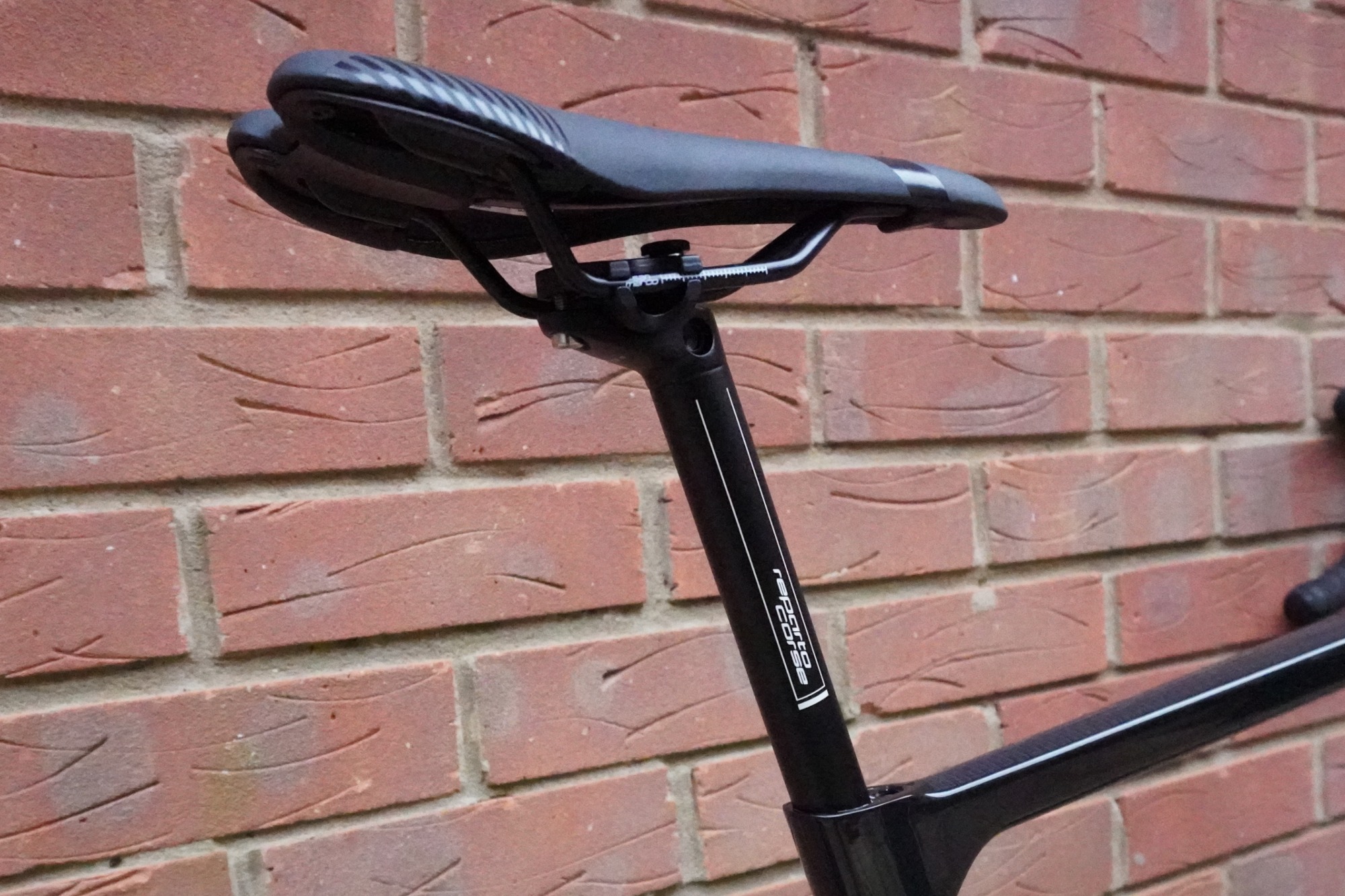
If you haven’t gotten your position completed dialled yet, this gives loads of flexibility for experimentation. Seatposts with different laybacks and stems of different lengths are cheap and easy to come by – and there’s a whole wide world of handlebars with different ergonomics to try out.
You can even give different stack heights a go without having to fully commit by chopping down your steerer tube – unlike with most fully integrated setups. All this makes a huge difference to your comfort and efficiency on the bike, which ultimately result in faster speeds.
And so it is really great to see a bike of this calibre being so amenable to getting a good fit.
However, considering the price of this bike, it does feel like you are paying a lot of money for equipment that is quite basic. That’s not to say it would be better if the finishing kit were much more integrated or made from carbon – the former would lose the excellent compatibility while the latter would cost a lot without really providing that significant gains.
What I’d really want is for the money saved on the finishing kit to either result in a cheaper bike or to be spent on the wheels which, as we’ll come onto, are also quite basic.
But, stepping back a moment, it’s quite easy to understand why the spec and the price don’t seem to line up. Founded in 1885, Bianchi is the oldest bike producer still running – part of what you pay is for the brand name and the heritage. Also, in having a more traditional sales model, it’s never going to be able to compete with brands that sell directly to consumers.
Wheels and tyres
The wheels are the Fulcrum 618 DB, which are an OEM version of the Fulcrum 6 DB. As aluminium wheels go, they’re not particularly heavy and, although shallow, they do at least have some depth over a simple box section.
In terms of reliability, they’ve put up a good showing, with the bearings continuing to run silky smooth and the rim still perfectly true. They’d be worth keeping as a set of training wheels, but an upgrade to some deep section carbon rims would be a much more matched compliment to the frame.
Although the wheels are tubeless ready, the Vittoria Rubino IV Graphene 2.0 are not. This is probably actually a good choice. Sealant tends to dry out after a few months, so selling a bike with freshly topped up tyres does add logistical complications – although some brands do manage it.
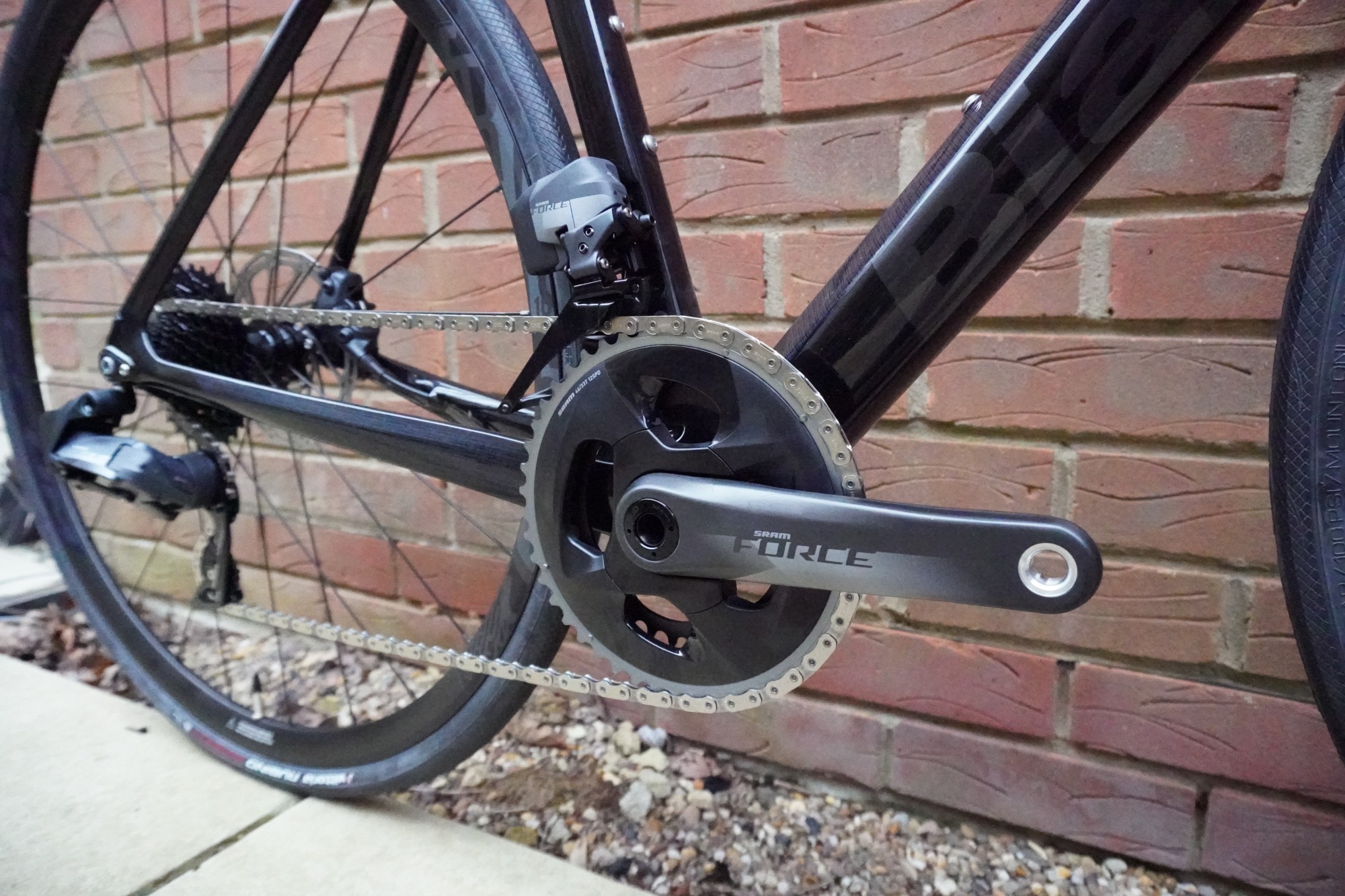
Because tubeless tyres tend not to be as supple as clinchers when run with inner tubes – and as most people tend to stick with the stock setup – it makes sense for the tyres to be optimised for clinchers.
And the Rubinos in a 28c are a pretty good choice. They are fairly fast rolling and offer good puncture resistance. They’re not the best in any respect, but as a reasonably priced all-rounder, they don’t detract from the bike and they don’t inflate the cost.
The frame can take rubber up to 32c, which is very generous for a race bike – making the Sprint a particularly good choice for cobbled sportives
Groupset
It’s SRAM’s Force eTap AXS for the groupset, and the hydraulic disc brakes are great as ever. Powerful and assured stopping no matter the conditions, all the while not wearing through your rims. Bleeding SRAM brakes is a bit more of a faff than Shimano, but the principles are the same and it’s not something that needs doing often.
Onto the gearing, we have specced a 46/33 crankset and a 10-33 cassette. In going 12 speed and adding a 10 tooth smallest sprocket to the cassette, SRAM was able to shrink the size of the chainrings while still providing a large top gear. 46x10 is a bit bigger than 50x11, although a little smaller than 52x11 – the two sizes of big ring most people have experience of.
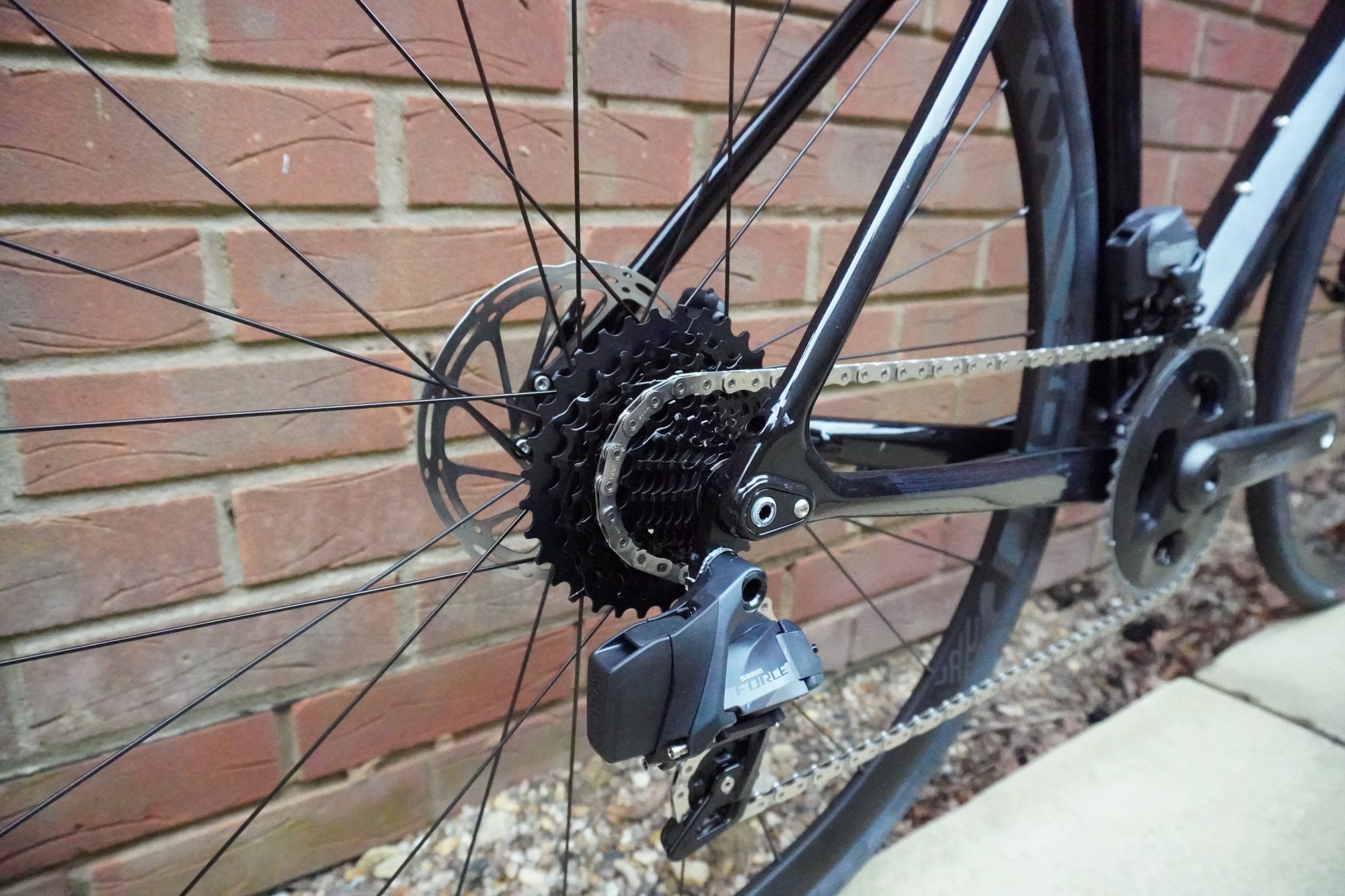
For a bike with Sprint in the name, I was a little surprised that the 48/35 crankset, which SRAM suggests as a replacement for a 52/36 wasn’t used. But after spending a lot of time aboard the Sprint, I think that the gear choice is actually spot on. The top gear is large enough that you rarely feel as if you are spinning out.
The ride
The Sprint was excellent, with a positive feel when putting in hard accelerations and quite fast on the flat – even with the shallow alloy rims. Although there was very little discernible flex in the frame, this didn’t translate to a harsh feeling ride – which I imagine is largely thanks to the wide 28c tyres.
Noticing the bottom gear gave a 1:1 ratio, I took the opportunity to use it for an Everesting – which is a pretty thorough test of a bike’s endurance capabilities, if ever there was one.
And throughout that ride, the handling on the descents was really well balanced. Although quick and responsive, it didn’t tip over into the realm of ‘twitchy’ – meaning not only was I able to take it relatively fast on the descents, but I felt confident in doing so.
I got on very well with the gearing for just general riding as well. With the smaller front ring and wide range cassette, I could essentially treat the drivetrain as a 1x, with the inner ring as simply a bailout option for obscenely steep hills and recovery rides.
Cycling around Sussex, I hardly ever needed to shift the small ring, which was a great help when attacking climbs with really inconsistent gradients, continually ramping up and then flatten off. Normally these are quite frustrating, with time wasted from repeatedly shifting rings. But on the Sprint, I wouldn’t have to concern myself with any shifts at the front, and could just be completely sequential at the back.
Value
Obviously brands such as Vitus or Ribble – with their direct sales models – will be able to sell a bike with a higher spec for a lower price. But even compared to more established brands such as BMC, the Bianchi Sprint doesn’t fair too favourably.
The BMC Teammachine SLR One costs £5,000 and for that, you get carbon wheels, carbon finishing kit and a much more integrated cockpit. The Sprint, in comparison, costs £4,600 and has shallow alloy wheels, alloy finishing kit and much less integrated around the head tube, stem and handlebars.

Thank you for reading 20 articles this month* Join now for unlimited access
Enjoy your first month for just £1 / $1 / €1
*Read 5 free articles per month without a subscription

Join now for unlimited access
Try first month for just £1 / $1 / €1
Get The Leadout Newsletter
The latest race content, interviews, features, reviews and expert buying guides, direct to your inbox!

After winning the 2019 National Single-Speed Cross-Country Mountain Biking Championships and claiming the plushie unicorn (true story), Stefan swapped the flat-bars for drop-bars and has never looked back.
Since then, he’s earnt his 2ⁿᵈ cat racing licence in his first season racing as a third, completed the South Downs Double in under 20 hours and Everested in under 12.
But his favourite rides are multiday bikepacking trips, with all the huge amount of cycling tech and long days spent exploring new roads and trails - as well as histories and cultures. Most recently, he’s spent two weeks riding from Budapest into the mountains of Slovakia.
Height: 177cm
Weight: 67–69kg
-
 Cycling's riders need more protection from mindless 'fans' at races to avoid another Mathieu van der Poel Paris-Roubaix bottle incident
Cycling's riders need more protection from mindless 'fans' at races to avoid another Mathieu van der Poel Paris-Roubaix bottle incidentCycling's authorities must do everything within their power to prevent spectators from assaulting riders
By Tom Thewlis Published
-
 Man hands himself in to Belgian police after throwing full water bottle at Mathieu van der Poel during Paris-Roubaix
Man hands himself in to Belgian police after throwing full water bottle at Mathieu van der Poel during Paris-Roubaix30-year-old was on Templeuve-en-Pévèle cobbled sector when television pictures showed the bottle hitting him in the face
By Tom Thewlis Published
-
 'I'll take a top 10, that's alright in the end' - Fred Wright finishes best of British at Paris-Roubaix
'I'll take a top 10, that's alright in the end' - Fred Wright finishes best of British at Paris-RoubaixBahrain-Victorious rider came back from a mechanical on the Arenberg to place ninth
By Adam Becket Published